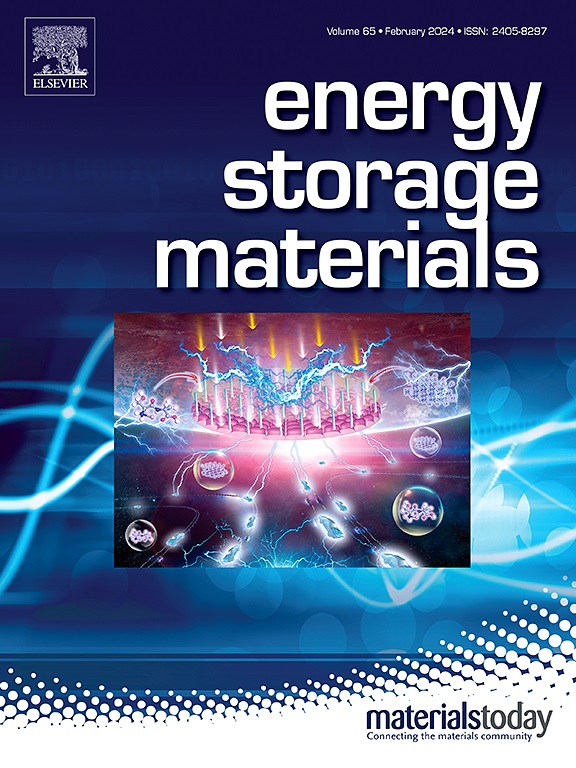Metal-organic polyhedrons modulated eccentric solvation sheath enables fast charge transfer kinetics in nonaqueous Zn electrolytes
IF 18.9
1区 材料科学
Q1 CHEMISTRY, PHYSICAL
引用次数: 0
Abstract
Zn batteries emerge as a promising class of energy storage devices with high energy density, low cost and high safety. Nonaqueous Zn electrolytes offer high interfacial stability yet suffer from sluggish interfacial charge transfer kinetics. Here, we report an eccentric Zn2+ solvation structure enabled by metal-organic polyhedrons (MOPs) in nonaqueous colloidal electrolytes, which facilitates charge transfer at electrode-electrolyte interface. The resultant Zn2+(ZrT)(DMF)1 solvation structure features a large solvation sheath and a small ion-to-electrode distance, thus reducing the energy required for reorganizing the solvation sheath to accept electron. As a result, the MOPs-modulated colloidal electrolyte enables Zn anode with supreme stability for over 1200 h at 8 mA cm−2 and 270 h at 12 mA cm−2, along with high coulombic efficiency (∼99.8 % over 1000 cycles), notably exceeding the performance of conventional aqueous and nonaqueous electrolytes. The design principle of solvation sheath might be broadly applicable to other high-valence metal cation batteries.
金属-有机多面体调制偏心溶剂化护套实现非水锌电解质的快速电荷转移动力学
锌电池具有高能量密度、低成本、高安全性等优点,是一种极具发展前景的储能设备。非水锌电解质具有较高的界面稳定性,但界面电荷转移动力学缓慢。在这里,我们报道了金属有机多面体(MOPs)在非水胶体电解质中的偏心Zn2+溶剂化结构,促进了电极-电解质界面的电荷转移。所得的Zn2+(ZrT)(DMF)1溶剂化结构具有较大的溶剂化鞘层和较小的离子-电极距离,从而减少了重组溶剂化鞘层以接受电子所需的能量。结果,mops调制的胶体电解质使锌阳极在8 mA cm - 2下具有超过1200小时的最高稳定性,在12 mA cm - 2下具有270小时的最高稳定性,以及高库仑效率(超过1000次循环约99.8%),明显超过传统的水和非水电解质的性能。溶剂化护套的设计原理可广泛适用于其他高价金属阳离子电池。
本文章由计算机程序翻译,如有差异,请以英文原文为准。
求助全文
约1分钟内获得全文
求助全文
来源期刊

Energy Storage Materials
Materials Science-General Materials Science
CiteScore
33.00
自引率
5.90%
发文量
652
审稿时长
27 days
期刊介绍:
Energy Storage Materials is a global interdisciplinary journal dedicated to sharing scientific and technological advancements in materials and devices for advanced energy storage and related energy conversion, such as in metal-O2 batteries. The journal features comprehensive research articles, including full papers and short communications, as well as authoritative feature articles and reviews by leading experts in the field.
Energy Storage Materials covers a wide range of topics, including the synthesis, fabrication, structure, properties, performance, and technological applications of energy storage materials. Additionally, the journal explores strategies, policies, and developments in the field of energy storage materials and devices for sustainable energy.
Published papers are selected based on their scientific and technological significance, their ability to provide valuable new knowledge, and their relevance to the international research community.
 求助内容:
求助内容: 应助结果提醒方式:
应助结果提醒方式:


